fog light MITSUBISHI ECLIPSE CROSS 2020 Owner's Manual (in English)
[x] Cancel search | Manufacturer: MITSUBISHI, Model Year: 2020, Model line: ECLIPSE CROSS, Model: MITSUBISHI ECLIPSE CROSS 2020Pages: 427, PDF Size: 78.05 MB
Page 5 of 427
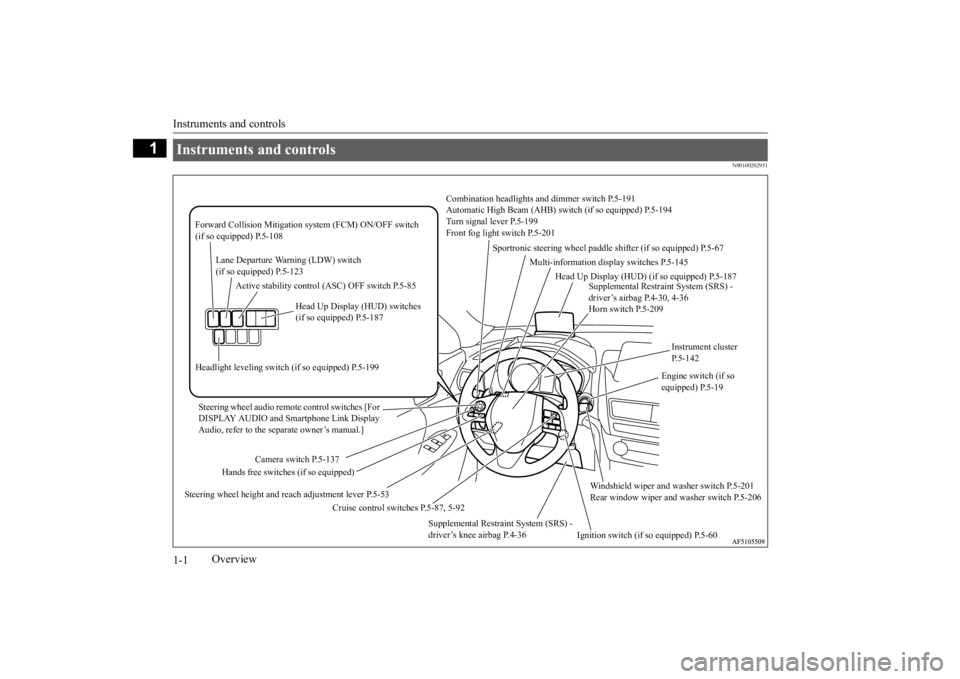
Instruments and controls 1-1
1
Overview
N00100202951
Instruments and controls
Combination headlights an
d dimmer switch P.5-191
Automatic High Beam (AHB) sw
itch (if so equipped) P.5-194
Turn signal lever P.5-199 Front fog light switch P.5-201
Steering wheel audio remote control switches [For DISPLAY AUDIO and Smartphone Link Display Audio, refer to the separate owner’s manual.]
Active stability control (ASC) OFF switch P.5-85
Supplemental Restraint System (SRS) - driver’s airbag P.4-30, 4-36Horn switch P.5-209
Instrument cluster P.5-142
Windshield wiper and washer switch P.5-201 Rear window wiper and
washer switch P.5-206
Cruise control switches P.5-87, 5-92
Steering wheel height and reach adjustment lever P.5-53
Engine switch (if so equipped) P.5-19
Sportronic steering wheel paddle
shifter (if so equipped) P.5-67
Lane Departure Warning (LDW) switch (if so equipped) P.5-123
Forward Collision Mitigation
system (FCM) ON/OFF switch
(if so equipped) P.5-108
Supplemental Restraint System (SRS) - driver’s knee airbag P.4-36
Ignition switch (if so equipped) P.5-60
Head Up Display (HUD) switches (if so equipped) P.5-187
Headlight leveling switch
(if so equipped) P.5-199
Camera switch P.5-137
Hands free switches (if so equipped)
Multi-information display switches P.5-145
Head Up Display (HUD)
(if so equipped) P.5-187
BK0277700US.bo
ok 1 ページ 2019年3月8日 金曜日 午前9時23分
Page 6 of 427
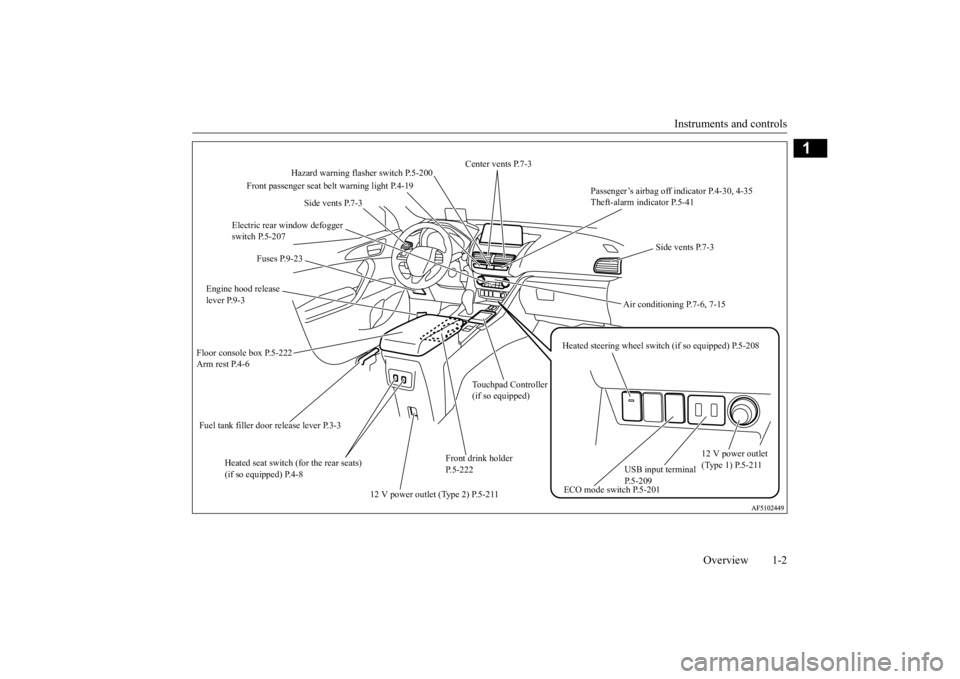
Instruments and controls
Overview 1-2
1
Hazard warning flasher switch P.5-200
Electric rear window defogger switch P.5-207
Fuel tank filler door release lever P.3-3 Engine hood release lever P.9-3 Floor console box P.5-222 Arm rest P.4-6
12 V power outlet (Type 1) P.5-211
Air conditioning P.7-6, 7-15
Passenger’s airbag off indicator P.4-30, 4-35 Theft-alarm indicator P.5-41
Front passenger seat belt warning light P.4-19
Heated steering wheel switc
h (if so equipped) P.5-208
Heated seat switch (for the rear seats) (if so equipped) P.4-8
Side vents P.7-3
ECO mode switch P.5-201
USB input terminal P.5-209
Center vents P.7-3
Fuses P.9-23
Front drink holder P.5-222
Side vents P.7-3
12 V power outlet (Type 2) P.5-211
Touchpad Controller (if so equipped)
BK0277700US.bo
ok 2 ページ 2019年3月8日 金曜日 午前9時23分
Page 11 of 427
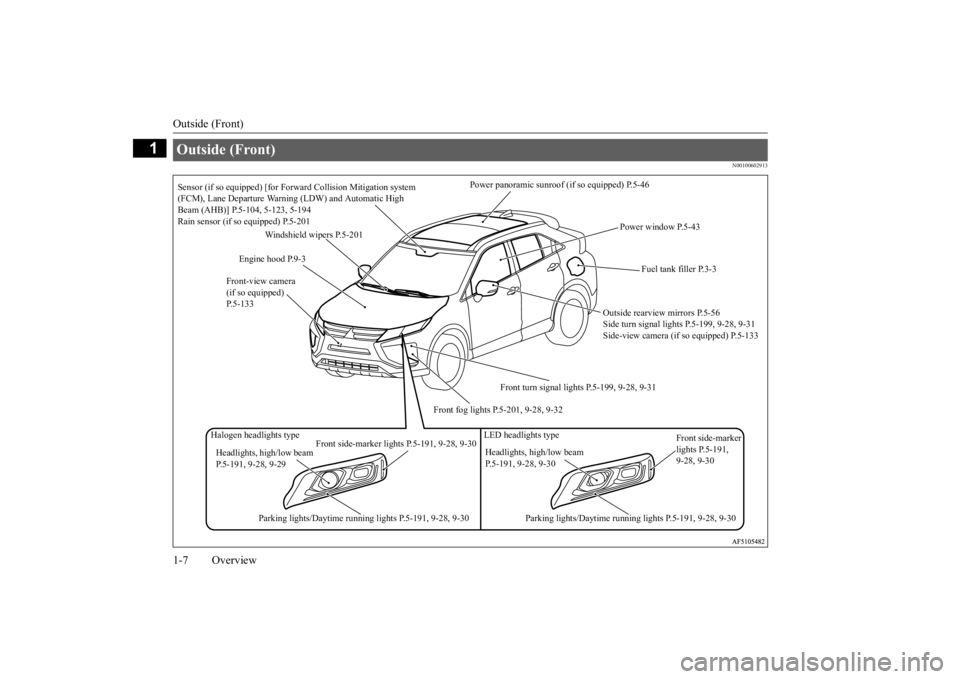
Outside (Front) 1-7 Overview
1
N00100602913
Outside (Front)
Power panoramic sunroof
(if so equipped) P.5-46
Windshield wipers P.5-201
Engine hood P.9-3
Front fog lights P.5-201, 9-28, 9-32
Outside rearview mirrors P.5-56 Side turn signal lights P.5-199, 9-28, 9-31Side-view camera (if so equipped) P.5-133
Fuel tank filler P.3-3
Power window P.5-43
Front turn signal lights P.5-199, 9-28, 9-31
Headlights, high/low beam P.5-191, 9-28, 9-29
Headlights, high/low beam P.5-191, 9-28, 9-30
Parking lights/Daytime running lights P.5-191, 9-28, 9-30
Parking lights/Daytime running lights P.5-191, 9-28, 9-30
Halogen headlights type LED headlights type
Front side-marker lights P.5-191, 9-28, 9-30
Front side-marker lights P.5-191, 9-28, 9-30
Sensor (if so equipped) [for Fo
rward Collision Mitigation system
(FCM), Lane Departure Warn
ing (LDW) and Automatic High
Beam (AHB)] P.5-104, 5-123, 5-194 Rain sensor (if so equipped) P.5-201
Front-view camera (if so equipped) P.5-133
BK0277700US.bo
ok 7 ページ 2019年3月8日 金曜日 午前9時23分
Page 18 of 427
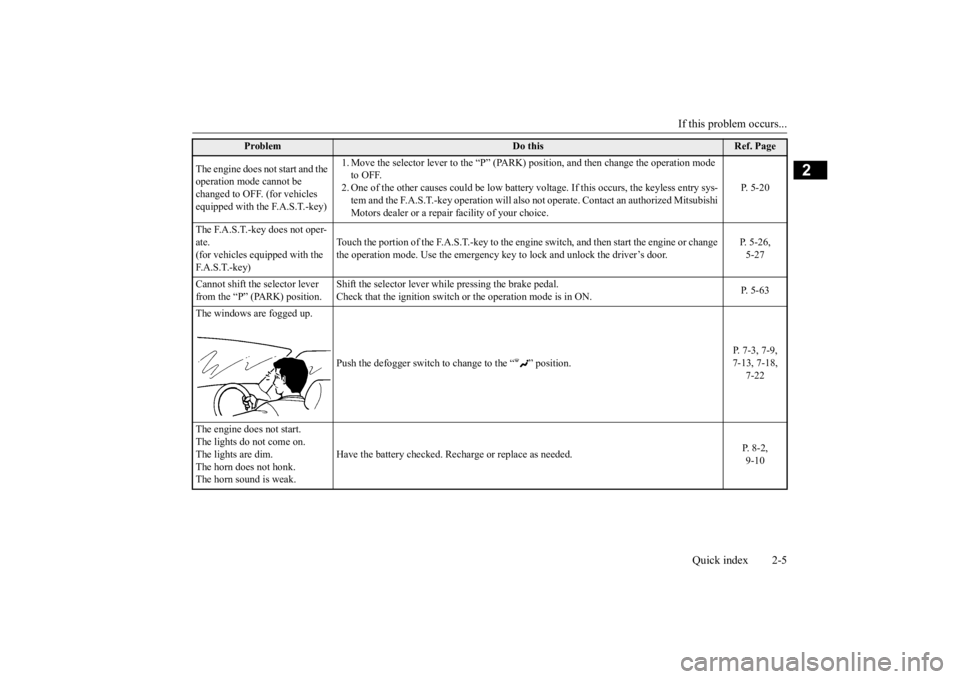
If this problem occurs...
Quick index 2-5
2
The engine does not start and the operation mode cannot be changed to OFF. (for vehicles equipped with the F.A.S.T.-key)
1. Move the selector lever to the “P” (PARK)
position, and then change the operation mode
to OFF. 2. One of the other causes could be low battery
voltage. If this occurs, the keyless entry sys-
tem and the F.A.S.T.-key operation will also no
t operate. Contact an authorized Mitsubishi
Motors dealer or a repair facility of your choice.
P. 5-20
The F.A.S.T.-key does not oper- ate.(for vehicles equipped with the F. A . S . T. - k e y )
Touch the portion of the F.A.S.T.-key to the engine
switch, and then start the engine or change
the operation mode. Use the emergency key to lock and unlock the driver’s door.
P. 5-26, 5-27
Cannot shift the selector lever from the “P” (PARK) position.
Shift the selector lever while pressing the brake pedal. Check that the ignition switch or the operation mode is in ON.
P. 5-63
The windows are fogged up.
Push the defogger switch to
change to the “ ” position.
P. 7-3, 7-9, 7-13, 7-18,
7-22
The engine does not start. The lights do not come on. The lights are dim.The horn does not honk. The horn sound is weak.
Have the battery checked. Recharge or replace as needed.
P. 8-2, 9-10
Problem
Do this
Ref. Page
BK0277700US.bo
ok 5 ページ 2019年3月8日 金曜日 午前9時23分
Page 106 of 427
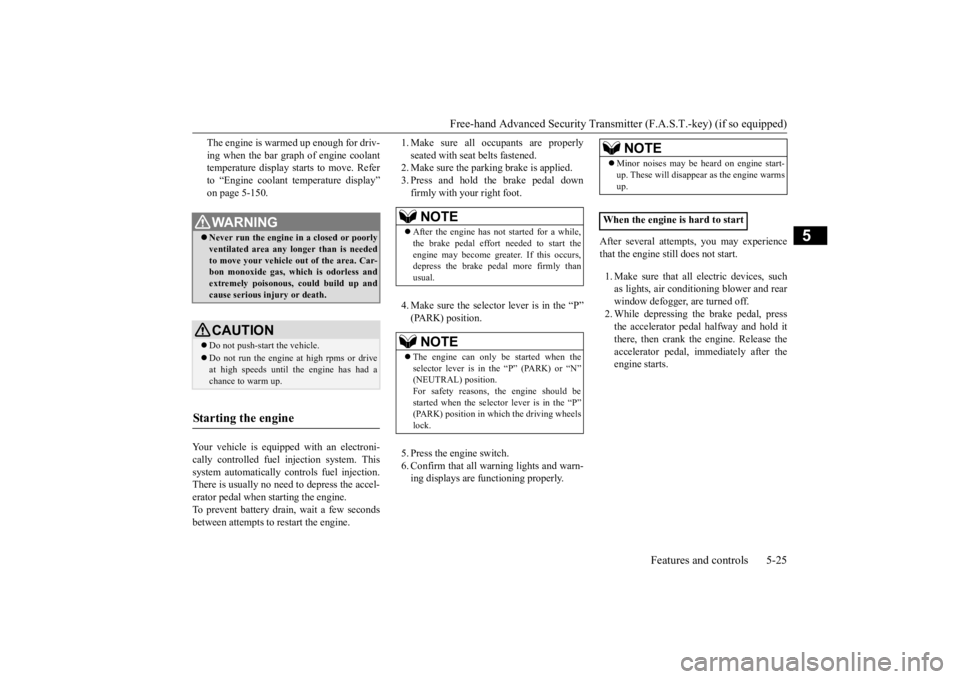
Free-hand Advanced Security Transmit
ter (F.A.S.T.-key) (if so equipped)
Features and controls 5-25
5
The engine is warmed up enough for driv- ing when the bar graph of engine coolant temperature display starts to move. Refer to “Engine coolant temperature display”on page 5-150.
Your vehicle is equipped with an electroni- cally controlled fuel injection system. This system automatically controls fuel injection.There is usually no need to depress the accel- erator pedal when starting the engine. To prevent battery drain, wait a few secondsbetween attempts to restart the engine.
1. Make sure all occupants are properly seated with seat belts fastened. 2. Make sure the parking brake is applied. 3. Press and hold the brake pedal downfirmly with your right foot. 4. Make sure the selector lever is in the “P” (PARK) position. 5. Press the engine switch. 6. Confirm that all warning lights and warn- ing displays are functioning properly.
After several attempts, you may experience that the engine still does not start. 1. Make sure that all electric devices, such as lights, air conditioning blower and rearwindow defogger, are turned off. 2. While depressing the brake pedal, press the accelerator pedal halfway and hold itthere, then crank the engine. Release the accelerator pedal, immediately after the engine starts.
WA R N I N G Never run the engine in a closed or poorly ventilated area any longer than is needed to move your vehicle out of the area. Car-bon monoxide gas, which is odorless and extremely poisonous, could build up and cause serious injury or death.CAUTION Do not push-start the vehicle.Do not run the engine at high rpms or drive at high speeds until the engine has had a chance to warm up.
Starting the engine
NOTE
After the engine has not started for a while, the brake pedal effort needed to start theengine may become greater. If this occurs, depress the brake pedal more firmly than usual.NOTE
The engine can only be started when the selector lever is in the “P” (PARK) or “N”(NEUTRAL) position. For safety reasons, the engine should be started when the selector lever is in the “P”(PARK) position in which the driving wheels lock.
NOTE
Minor noises may be heard on engine start- up. These will disappear as the engine warms up.
When the engine is hard to start
BK0277700US.bo
ok 25 ページ 2019年3月8日 金曜日 午前9時23分
Page 140 of 427

Outside rearview mirrors
Features and controls 5-59
5
The Integrated Blind Spot Mirror (A) is a mirror for showing vehicles and other objects in the driver's blind spot (C) that are not shown in the main mirror (B).When checking the area to the rear of your vehicle, check the main mirror (B), and then check the Integrated Blind Spot Mirror (A).
N00549301332
When the rear window defogger switch ispressed with the engine running, the outside rearview mirrors are defogged or defrosted. Current will flow through the heater elementinside the mirrors, thus clearing away frost or condensation. The indicator light (A) will illuminate whilethe defogger is on. The heater will be turned off automatically in approximately 15 to 20 minutes depending onthe outside temperature.
D- When a vehicle is traveling far behind
your vehicle, the main mirror (B) shows an image of the vehicle and the Inte-grated Blind Spot Mirror (A) shows a small image of the vehicle.
E- When the vehicle moves closer to your
vehicle, the main mirror (B) shows a larger image of the vehicle and the Inte- grated Blind Spot Mirror (A) also showsa larger image of the vehicle.
F- When the vehicle moves even closer to
your vehicle and is lo
cated in the driver's
blind spot (C), the main mirror (B) does not show an image of the vehicle and only the Integrated Blind Spot Mirror(A) shows an image of the vehicle.
Heated outside rearview mirror
BK0277700US.bo
ok 59 ページ 2019年3月8日 金曜日 午前9時23分
Page 143 of 427
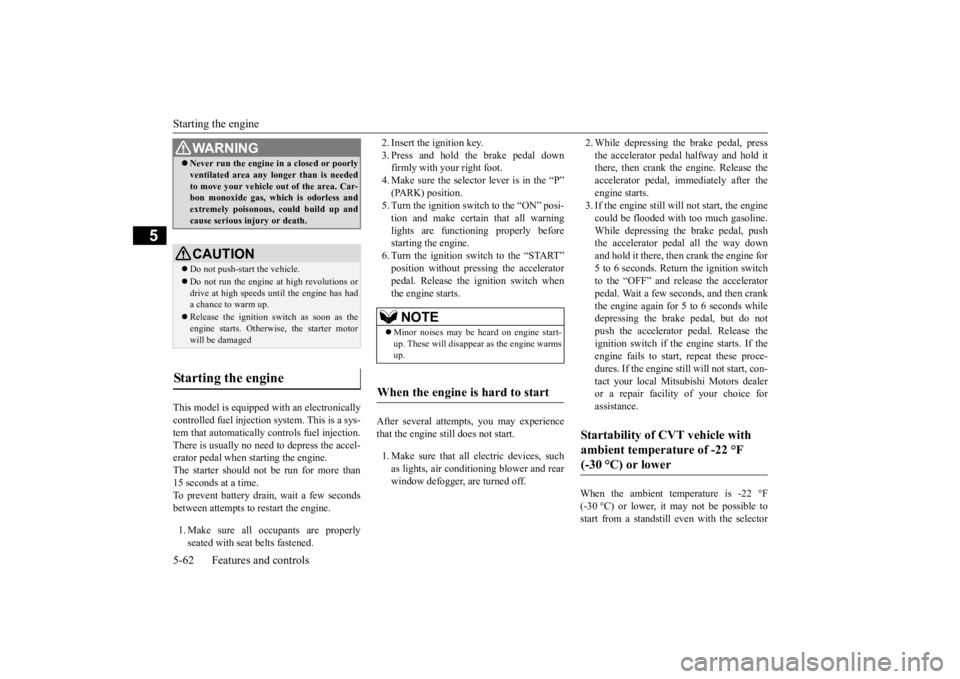
Starting the engine 5-62 Features and controls
5
This model is equipped with an electronically controlled fuel injection system. This is a sys- tem that automatically controls fuel injection.There is usually no need to depress the accel- erator pedal when starting the engine. The starter should not be run for more than15 seconds at a time. To prevent battery drain, wait a few seconds between attempts to restart the engine. 1. Make sure all occupants are properly seated with seat belts fastened.
2. Insert the ignition key. 3. Press and hold the brake pedal down firmly with your right foot. 4. Make sure the selector lever is in the “P”(PARK) position. 5. Turn the ignition switch to the “ON” posi- tion and make certain that all warninglights are functioning properly before starting the engine. 6. Turn the ignition switch to the “START”position without pressing the acceleratorpedal. Release the ignition switch when the engine starts.
After several attempts, you may experience that the engine still does not start. 1. Make sure that all electric devices, such as lights, air conditioning blower and rearwindow defogger, are turned off.
2. While depressing the brake pedal, press the accelerator pedal halfway and hold it there, then crank the engine. Release the accelerator pedal, immediately after theengine starts. 3. If the engine still will not start, the engine could be flooded with too much gasoline.While depressing the brake pedal, push the accelerator pedal all the way down and hold it there, then crank the engine for5 to 6 seconds. Return the ignition switchto the “OFF” and release the accelerator pedal. Wait a few seconds, and then crank the engine again for 5 to 6 seconds whiledepressing the brake pedal, but do not push the accelerator pedal. Release the ignition switch if the engine starts. If theengine fails to start, repeat these proce- dures. If the engine st
ill will not start, con-
tact your local Mitsubishi Motors dealeror a repair facility of your choice for assistance.
When the ambient temperature is -22 °F (-30 °C) or lower, it may not be possible tostart from a standstill even with the selector
WA R N I N G Never run the engine in a closed or poorly ventilated area any longer than is needed to move your vehicle out of the area. Car- bon monoxide gas, which is odorless and extremely poisonous, could build up andcause serious injury or death.CAUTION Do not push-start the vehicle.Do not run the engine at high revolutions or drive at high speeds until the engine has hada chance to warm up. Release the ignition switch as soon as the engine starts. Otherwise, the starter motor will be damaged
Starting the engine
NOTE
Minor noises may be heard on engine start- up. These will disappear as the engine warms up.
When the engine is hard to start
Startability of CVT vehicle with ambient temperature of -22 °F (-30 °C) or lower
BK0277700US.bo
ok 62 ページ 2019年3月8日 金曜日 午前9時23分
Page 188 of 427
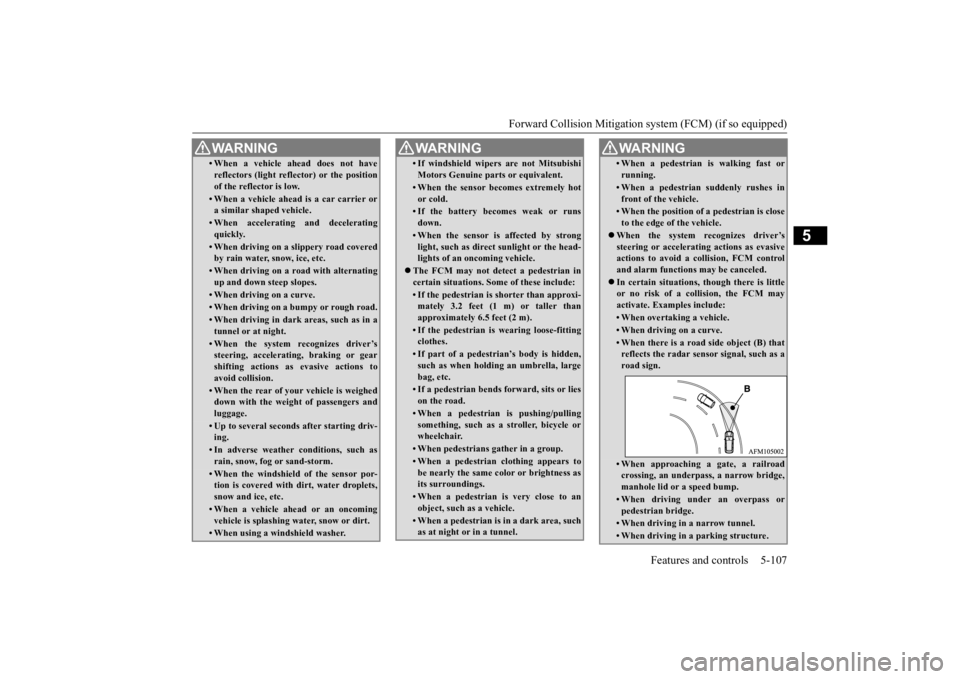
Forward Collision Mitigation sy
stem (FCM) (if so equipped) Features and controls 5-107
5
• When a vehicle ahead does not have reflectors (light reflector) or the position of the reflector is low.• When a vehicle ahead is a car carrier ora similar shaped vehicle.• When accelerating and deceleratingquickly.• When driving on a slippery road coveredby rain water, snow, ice, etc.• When driving on a road with alternatingup and down steep slopes.• When driving on a curve.• When driving on a bumpy or rough road.• When driving in dark areas, such as in a tunnel or at night.• When the system recognizes driver’ssteering, accelerating, braking or gear shifting actions as evasive actions toavoid collision.• When the rear of your vehicle is weigheddown with the weight of passengers and luggage.• Up to several seconds after starting driv-ing.• In adverse weather conditions, such asrain, snow, fog or sand-storm.• When the windshield of the sensor por- tion is covered with dirt, water droplets,snow and ice, etc.• When a vehicle ahead or an oncomingvehicle is splashing water, snow or dirt. • When using a windshield washer.WA R N I N G
• If windshield wipers are not Mitsubishi Motors Genuine parts or equivalent. • When the sensor becomes extremely hot or cold.• If the battery becomes weak or runsdown.• When the sensor is affected by stronglight, such as direct sunlight or the head-lights of an oncoming vehicle.
The FCM may not detect a pedestrian in certain situations. Some of these include:• If the pedestrian is shorter than approxi-mately 3.2 feet (1 m) or taller than approximately 6.5 feet (2 m).• If the pedestrian is wearing loose-fittingclothes.• If part of a pedestrian’s body is hidden,such as when holding an umbrella, large bag, etc.• If a pedestrian bends forward, sits or lieson the road.• When a pedestrian is pushing/pullingsomething, such as a stroller, bicycle orwheelchair.• When pedestrians gather in a group.• When a pedestrian clothing appears tobe nearly the same color or brightness as its surroundings.• When a pedestrian is very close to anobject, such as a vehicle.• When a pedestrian is in a dark area, suchas at night or in a tunnel.WA R N I N G
• When a pedestrian is walking fast orrunning.• When a pedestrian suddenly rushes in front of the vehicle.• When the position of a pedestrian is closeto the edge of the vehicle.
When the system recognizes driver’s steering or accelerating actions as evasiveactions to avoid a collision, FCM control and alarm functions may be canceled. In certain situations, though there is little or no risk of a collision, the FCM may activate. Examples include: • When overtaking a vehicle.• When driving on a curve.• When there is a road side object (B) thatreflects the radar sensor signal, such as a road sign.• When approaching a gate, a railroad crossing, an underpass, a narrow bridge, manhole lid or a speed bump.• When driving under an overpass orpedestrian bridge.• When driving in a narrow tunnel.• When driving in a parking structure.WA R N I N G
BK0277700US.book
107 ページ 2019年3月8日 金曜日 午前9時23分
Page 206 of 427
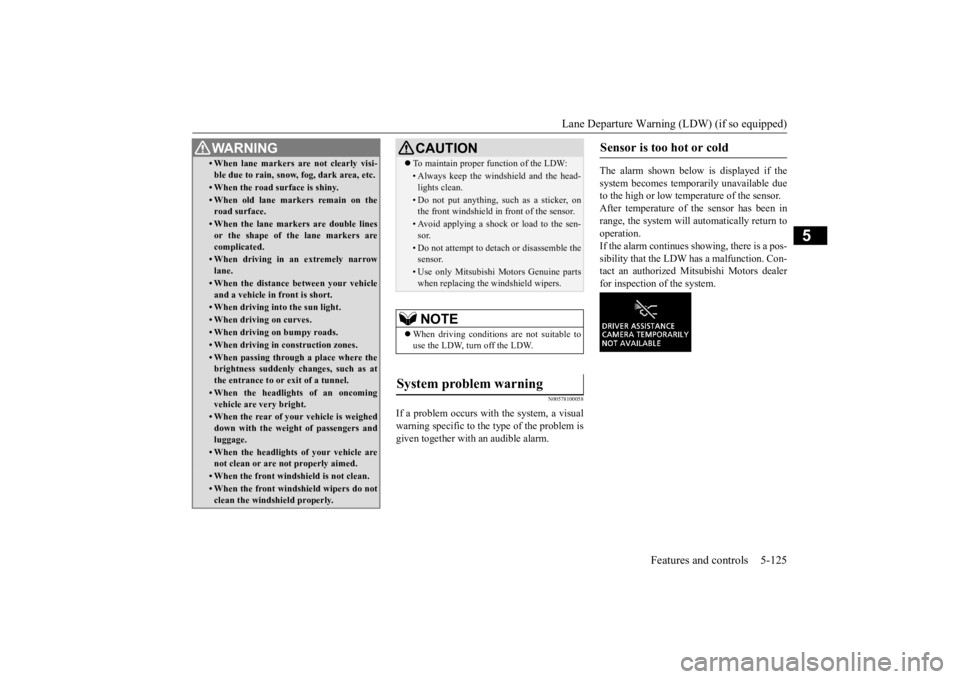
Lane Departure Warning (LDW) (if so equipped)
Features and controls 5-125
5
N00578100058
If a problem occurs with the system, a visual warning specific to the type of the problem isgiven together with an audible alarm.
The alarm shown below is displayed if the system becomes temporarily unavailable due to the high or low temperature of the sensor.After temperature of the sensor has been in range, the system will automatically return to operation.If the alarm continues showing, there is a pos- sibility that the LDW has a malfunction. Con- tact an authorized Mitsubishi Motors dealerfor inspection of the system.
• When lane markers are not clearly visi- ble due to rain, snow, fog, dark area, etc.• When the road surface is shiny.• When old lane markers remain on theroad surface.• When the lane markers are double linesor the shape of the lane markers are complicated.• When driving in an extremely narrowlane.• When the distance between your vehicleand a vehicle in front is short.• When driving into the sun light.• When driving on curves.• When driving on bumpy roads.• When driving in construction zones.• When passing through a place where the brightness suddenly changes, such as at the entrance to or exit of a tunnel.• When the headlights of an oncomingvehicle are very bright. • When the rear of your vehicle is weigheddown with the weight of passengers andluggage.• When the headlights of your vehicle arenot clean or are not properly aimed.• When the front windshield is not clean.• When the front windshield wipers do notclean the windshield properly.WA R N I N G
CAUTION To maintain proper function of the LDW:• Always keep the windshield and the head- lights clean.• Do not put anything, such as a sticker, onthe front windshield in front of the sensor.• Avoid applying a shock or load to the sen-sor.• Do not attempt to detach or disassemble thesensor.• Use only Mitsubishi Motors Genuine partswhen replacing the windshield wipers.NOTE
When driving conditions are not suitable to use the LDW, turn off the LDW.
System problem warning
Sensor is too hot or cold
BK0277700US.book
125 ページ 2019年3月8日 金曜日 午前9時23分
Page 244 of 427
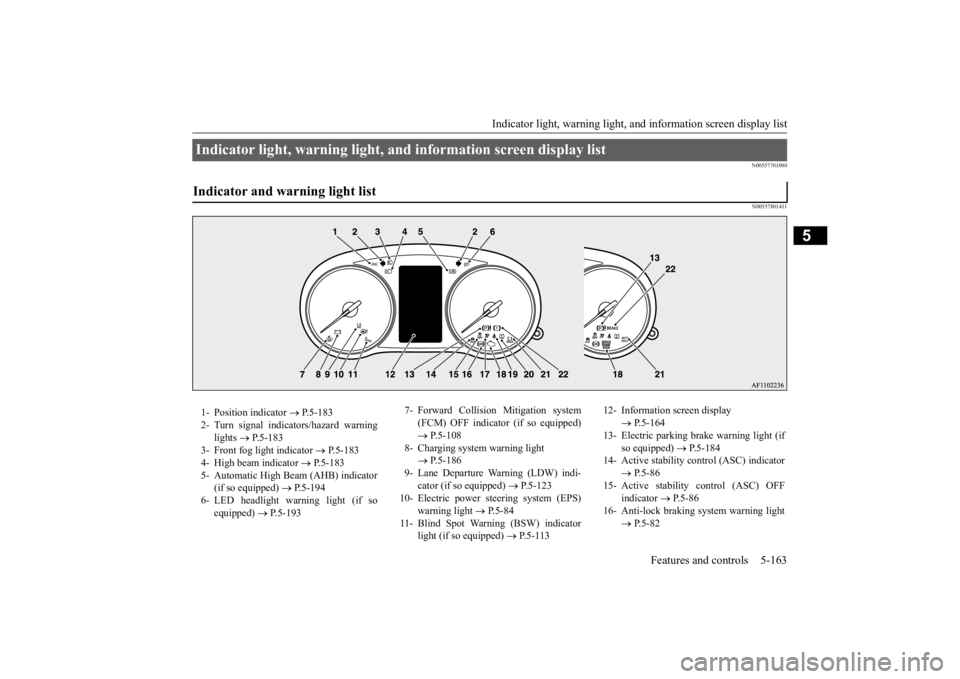
Indicator light, warning light, an
d information screen display list Features and controls 5-163
5
N00557701090 N00557801411
Indicator light, warning light, and information screen display list Indicator and warning light list 1- Position indicator
P.5-183
2- Turn signal indicators/hazard warning
lights
P.5-183
3- Front fog light indicator
P.5-183
4- High beam indicator
P.5-183
5- Automatic High Beam (AHB) indicator
(if so equipped)
P.5-194
6- LED headlight warning light (if so
equipped)
P.5-193
7- Forward Collision Mitigation system
(FCM) OFF indicator (if so equipped) P.5-108
8- Charging system warning light
P.5-186
9- Lane Departure Warning (LDW) indi-
cator (if so equipped)
P.5-123
10- Electric power steering system (EPS)
warning light
P.5-84
11- Blind Spot Warning (BSW) indicator
light (if so equipped)
P.5-113
12- Information screen display
P.5-164
13- Electric parking brake warning light (if
so equipped)
P.5-184
14- Active stability control (ASC) indicator
P.5-86
15- Active stability control (ASC) OFF
indicator
P.5-86
16- Anti-lock braking system warning light
P.5-82
BK0277700US.book
163 ページ 2019年3月8日 金曜日 午前9時23分